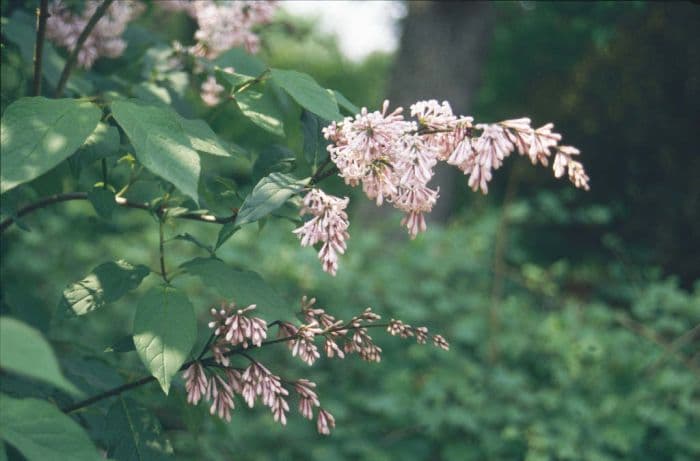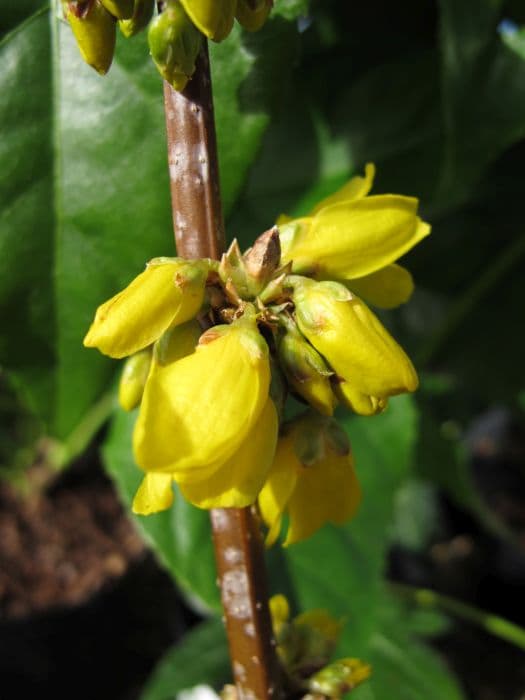Josiflexa Lilac Syringa × josiflexa 'Bellicent'

ABOUT
The plant known as the Lilac 'Bellicent' is a hybrid variety that showcases a multitude of appealing characteristics. It produces clusters of flowers that are a truly captivating sight when in bloom. These flowers typically emerge in a delightful shade of pink, with each individual blossom contributing to the striking overall effect of the large cluster. As the flowers mature, they may evolve in hue, imparting a multi-dimensional color experience throughout the blooming period. The leaves of the Lilac 'Bellicent' are also noteworthy, exhibiting a lush green color. They are heart-shaped with a smooth or slightly textured surface, providing a verdant backdrop for the floral display that can enhance any garden setting. As the seasons change, the foliage may exhibit some color transformation, offering continued visual interest even when the plant is not in flower. The Lilac 'Bellicent' is prized for its fragrance as well. The blooms exude a sweet and captivating scent that can fill a garden space, making it a favorite among those who appreciate fragrant plants. The plant’s form is generally rounded, lending itself to an aesthetically pleasing structure that can fit well within diverse landscape designs. Though the details of its size are omitted, it is worth noting that this cultivar's growth habit contributes to its overall charm and suitability for ornamental purposes.
About this plant
 Names
NamesFamily
Oleaceae
Synonyms
Joseph's Coat Lilac, Bellicent Lilac
Common names
Syringa × josiflexa 'Bellicent'.
 Toxicity
ToxicityTo humans
The Syringa × josiflexa 'Bellicent', commonly known as the hybrid lilac, is considered to have a low level of toxicity to humans. Ingesting parts of the plant, such as leaves, stems, or flowers, can potentially cause mild stomach upset, such as nausea or vomiting. However, significant poisoning is rare and typically associated with consuming large quantities of the plant material.
To pets
The hybrid lilac may have a mild level of toxicity to pets, similar to its effect on humans. If pets ingest parts of the plant, they might experience mild gastrointestinal upset, which could include symptoms such as vomiting or diarrhea. Serious cases of poisoning are uncommon, but if a pet consumes a large amount of plant material, it would be prudent to consult a veterinarian.
 Characteristics
CharacteristicsLife cycle
Perennials
Foliage type
Deciduous
Color of leaves
Green
Flower color
Pink
Height
8-10 feet (2.4-3.0 meters)
Spread
6-8 feet (1.8-2.4 meters)
Plant type
Shrub
Hardiness zones
4
Native area
Cultivar
Benefits
 General Benefits
General Benefits- Aesthetic Appeal: The Josiflexa Lilac 'Bellicent' offers beautiful pink flowers that can enhance the visual appeal of a garden or landscape.
- Fragrance: It emits a pleasant fragrance, which can create an enjoyable and aromatic environment in outdoor spaces.
- Attracts Pollinators: This lilac variety is known to attract bees, butterflies, and other beneficial pollinators, supporting biodiversity.
- Drought Resistance: Once established, it can tolerate periods of drought, making it suitable for climates with occasional water shortages.
- Low Maintenance: The Josiflexa Lilac 'Bellicent' requires minimal upkeep once it is settled in its location, making it an attractive option for gardeners of all skill levels.
- Seasonal Interest: It provides seasonal interest with its spring bloom, adding to the diversity of the landscape throughout the year.
- Privacy Screen: When planted in groups or rows, it can serve as an informal privacy screen or windbreak.
- Versatility: This lilac can be used in various landscape designs, including borders, hedging, or as a standalone specimen plant.
 Medical Properties
Medical PropertiesThis plant is not used for medical purposes.
 Air-purifying Qualities
Air-purifying QualitiesThis plant is not specifically known for air purifying qualities.
 Other Uses
Other Uses- Floral Arrangements: The flowers of the Syringa × josiflexa 'Bellicent', commonly known as Hyacinth Lilac, can be used in floral arrangements for their delightful fragrance and appealing color.
- Photography Prop: The lush blooms of Hyacinth Lilac can serve as an excellent prop for portrait and macro photography, offering a natural and colorful backdrop.
- Special Occasions: Due to its attractive flowers and fragrance, Hyacinth Lilac can be incorporated into wedding decorations, particularly in spring-themed weddings.
- Educational Tool: Educators can use the Hyacinth Lilac to teach botany and horticulture students about hybridization and plant propagation techniques.
- Art Inspiration: The vibrant color and form of Hyacinth Lilac blooms can inspire artists for paintings, drawings, and other forms of artistic expression.
- Perfumery: Hyacinth Lilac's scent can be captured and used as a basis for creating perfumes, although this is less common than using traditional lilac varieties.
- Scented Crafts: The dried flowers can be incorporated into potpourri or scented sachets to add a natural fragrance to drawers and closets.
- Horticultural Shows: Hyacinth Lilac can be cultivated for display in horticultural shows and competitions, showcasing the growers' skill in nurturing this hybrid.
- Natural Dye: The petals of Hyacinth Lilac may be used to create natural dyes for small-scale fabric dyeing projects, though this is not a typical use.
- Eco-Friendly Confetti: Dried Hyacinth Lilac petals can be used as biodegradable confetti for outdoor celebrations, reducing environmental impact.
Interesting Facts
 Feng Shui
Feng ShuiThe plant Syringa is not used in Feng Shui practice.
 Zodiac Sign Compitability
Zodiac Sign CompitabilityThe plant Syringa is not used in astrology practice.
 Plant Symbolism
Plant Symbolism- Rebirth and Renewal: As a member of the lilac family, Syringa × josiflexa 'Bellicent', commonly known as lilac, often symbolizes spring and the renewal that comes along with it.
- Innocence: The lilac is frequently associated with the innocence of youth, perhaps due to its soft and delicate blooms.
- First Love: Lilacs are often thought to represent a person's first emotions of love or the remembrance of a first love.
- Beauty: The captivating beauty of the lilac's flowers is symbolic of the beauty of nature or life itself.
- Spirituality: Some cultures view the sweet scent of lilac as a vehicle for spiritual encounters or as a symbol of the presence of divine energy.
- Confidence: Gifting lilacs or having them in one's home can symbolize a boost in confidence or a reminder of one's own self-assurance.
 Water
WaterThe Hybrid Lilac (Syringa × josiflexa 'Bellicent') should be watered deeply to ensure moisture reaches the root zone, approximately once a week during the growing season. In periods of drought or extreme heat, watering frequency should increase to twice a week. It's best to provide about 1 to 1.5 gallons of water at each watering session, allowing the soil to dry out slightly between waterings. Be cautious not to overwater, as this can lead to root rot.
 Light
LightHybrid Lilac (Syringa × josiflexa 'Bellicent') thrives in full sun, meaning it requires at least 6 hours of direct sunlight each day. The ideal spot for this plant is an area that receives unfiltered, full sunlight throughout the day. Avoid shady areas, as insufficient light can hinder blooming and lead to a sparser foliage growth.
 Temperature
TemperatureThe Hybrid Lilac (Syringa × josiflexa 'Bellicent') can tolerate a temperature range from about -20 to 90 degrees Fahrenheit, although it prefers temperate climates. The ideal temperature for optimal growth and flowering lies between 60 and 75 degrees Fahrenheit. It's hardy and winter-resistant, but prolonged periods of extreme heat or cold can be detrimental to the plant's health.
 Pruning
PruningPrune the Hybrid Lilac (Syringa × josiflexa 'Bellicent') immediately after the blooming period in late spring to encourage new growth and flowering for the next year. Deadhead spent flowers and remove any dead or crossing branches. Thinning out a few of the oldest stems each year will promote air circulation and rejuvenate the plant. Pruning every year or every other year is sufficient to maintain a healthy and aesthetically pleasing shape.
 Cleaning
CleaningAs needed
 Soil
SoilThe best soil mix for the hybrid lilac (Syringa × josiflexa 'Bellicent') should have good drainage and be rich in organic matter. Aim for a pH of 6.0 to 7.0. Mixing garden soil with compost and a small amount of perlite or sand can create an ideal environment for this lilac.
 Repotting
RepottingHybrid lilacs like Syringa × josiflexa 'Bellicent' don't usually require frequent repotting. It might be necessary to repot every 3-5 years, or when the plant has outgrown its current container or the soil is depleted.
 Humidity & Misting
Humidity & MistingThe hybrid lilac (Syringa × josiflexa 'Bellicent') prefers moderate humidity levels. Normal outdoor humidity is generally fine, but avoid placing the plant in overly dry or highly humid environments.
 Suitable locations
Suitable locationsIndoor
Ensure bright light, cool temps, and moderate humidity for the hybrid lilac.
Outdoor
Plant in well-draining soil, full sun, ensure moderate water.
Hardiness zone
3-7 USDA
 Life cycle
Life cycleThe common name for Syringa × josiflexa 'Bellicent' is Josiflexa Lilac. The life cycle begins with seed germination, where the plant starts as a seed and under proper conditions of moisture and temperature, it sprouts and emerges as a seedling. Afterward, it enters the vegetative growth stage, developing a sturdy stem, leaves, and a root system. Once mature, it transitions to the flowering stage, typically in late spring, where it produces fragrant blooms that range from white to pale lilac. The pollination process involves the transfer of pollen to fertilize the flowers, which can be aided by insects such as bees. Finally, after pollination, the plant produces seeds, completing its life cycle, and these seeds can be dispersed to give rise to new plants, continuing the species’ propagation.
 Propogation
PropogationPropogation time
Spring to Summer
The Syringa × josiflexa 'Bellicent', commonly known as the hybrid lilac 'Bellicent', is best propagated through softwood cuttings. This method is most effective when carried out in late spring to early summer, which typically aligns with the natural growth cycle of the plant when new, green shoots are most pliable and ready to root. To propagate by softwood cuttings, you should select a healthy, young shoot and cut a 4 to 6 inch (10 to 15 cm) portion, making the cut just below a leaf node. Strip the leaves from the lower half of the cutting, dip the cut end into rooting hormone to encourage root development, and then insert it into a well-drained soil mix. It's important to keep the cutting moist but not waterlogged and to provide a humid environment either by placing the pot in a plastic bag or using a propagation dome until roots have developed.








